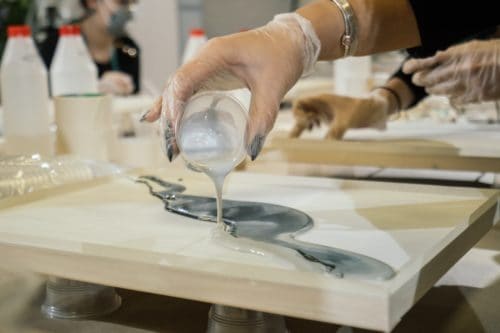Why Do Epoxies Yellow?
Leave a CommentEpoxy resins are commonly used for adhesives, protective coatings, and other construction applications. However, some lightly colored and white epoxies can start to yellow over time, ruining the appearance of the epoxy layer. This yellowing effect can seem random, but certain environmental factors can actually make epoxy more vulnerable to yellowing. In this blog, we’ll cover some of the most common causes of epoxy yellowing and how you can prevent it.
Why Epoxy Turns Yellow
 Epoxies tend to turn yellow as a result of UV radiation exposure. Although outdoor equipment is most vulnerable to this risk, indoor epoxy applications can also yellow because most windows do not sufficiently block UV radiation or lighting.
Epoxies tend to turn yellow as a result of UV radiation exposure. Although outdoor equipment is most vulnerable to this risk, indoor epoxy applications can also yellow because most windows do not sufficiently block UV radiation or lighting.
Some specialty epoxy resins can retain their original color despite prolonged sunlight exposure, but most epoxy resins will yellow over time. Here are the two most common reasons why epoxy turns yellow:
- Extended periods of high temperatures: Discoloration can happen if epoxy products sit in high temperatures for long periods of time, especially in locations without adequate climate control. Even ambient summer temperatures can accelerate yellowing. High temperatures can also damage the integrity of the epoxy resin.
- UV light exposure: Sunlight tends to make many plastics and polymers deteriorate, and epoxy resins are no exception. The epoxy molecules degrade over time as they interact with the light. This effect starts immediately, but the yellow color may not be visible until more damage accumulates.
How to Prevent Epoxy from Turning Yellow
To keep your epoxy components undamaged, you’ll need to make a preventative plan starting before the epoxy product is applied. To control heat generation, we recommend building thicker epoxy products from multiple thin layers, especially with standard epoxies. This allows each layer to properly cure at a controlled temperature. In contrast, pouring a thick mass of epoxy at once can generate enough heat to accelerate chemical reactions, resulting in cracks and discoloration. Manufacturers and hobbyists can also use specialty epoxies with UV stabilizers that are formulated to resist discoloration or handle higher heat levels.
Three key strategies for keeping epoxy from yellowing are:
- Using a sealer: Polyurethane sealants can protect the epoxy from molecular excitation in the presence of UV light and delay the discoloration process.
- Limiting UV exposure: The simplest way to prevent damage is to keep the epoxy shielded from sunlight.
- Choosing a yellow or darkly pigmented epoxy: Light-colored and white epoxy resins are the most vulnerable to yellowing. Epoxies that are already yellow or darkly colored will not show as much visible discoloration. This won’t remove the risk of cracks or other types of degradation, but it does improve the long-term appearance of epoxy.
Epoxy Resins from Copps Industries
At Copps Industries, we specialize in creating epoxy resins for commercial and industrial applications. We test every resin to ensure it meets or exceeds our quality assurance standards. Our products are built to serve diverse industries, including:
- Civil/Structural engineering
- Electrical
- Construction
- Aggregate craft epoxy
Contact Copps Industries for High-Performance Epoxy Resins
For over four decades, Copps Industries has been a leading provider of high-quality epoxy resins. Contact us today to learn about our selection of specialty and colorized epoxy products. You can also request a quote for custom pricing.



